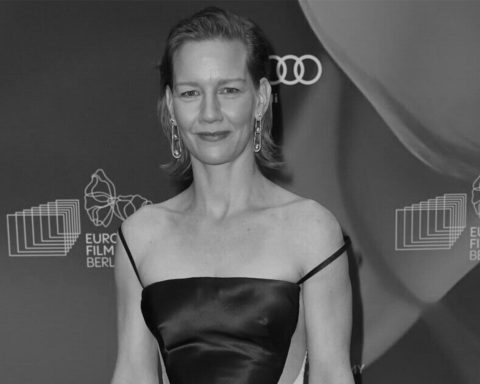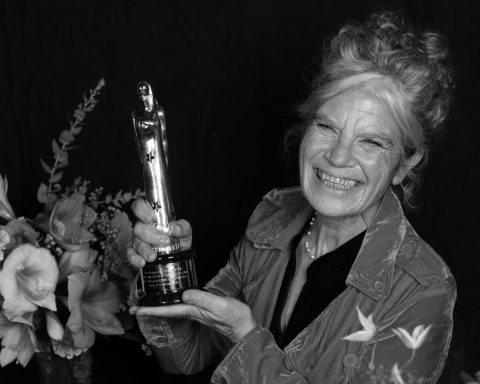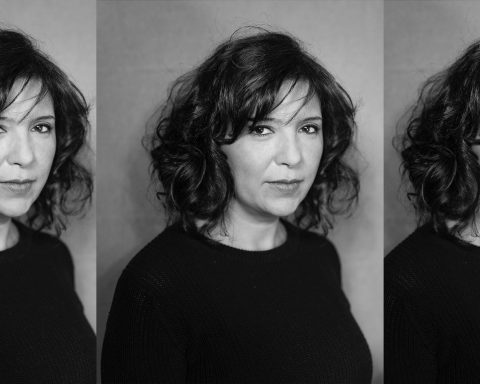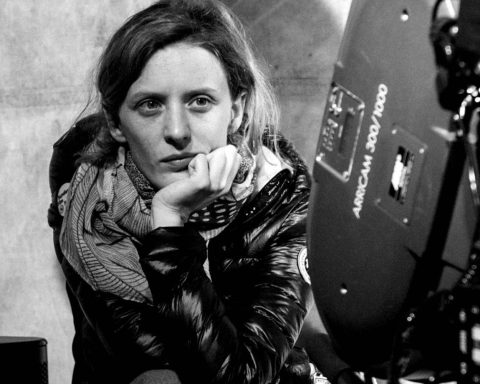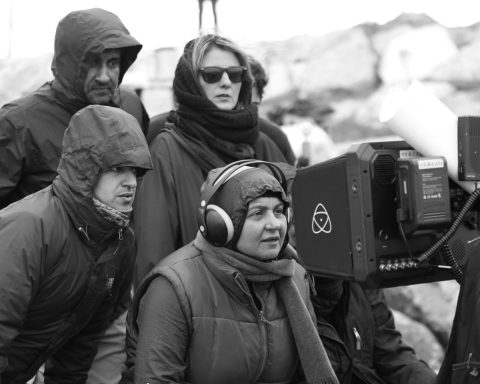Michelle Latimer is a Métis/Algonquin filmmaker and performer who employs art as an instrument of change. Having studied both Theater Performance and Film Studies at Concordia University, she has distinguished herself as a director, actor and producer. Her many film credits include “RISE,” a documentary series on Indigenous resistance and activism, “Choke,” that premiered at the Sundance Festival and won the Jury Prize Honorable Mention in International Short Filmmaking, screened at TIFF and was nominated for a Canadian Screen Award, “The Underground,” “Nimmikaage” and the feature doc “Alias,” also nominated for a Canadian Screen Award. She is currently showrunner and director on the series “Trickster,” that premiered on CBC this fall and that has already been picked up for a second season. She is also collaborating with Sienna Films to develop a feature film about Canada’s only female, dangerous offender, and has worked with the National Film Board of Canada and 90th Parallel Pictures to adapt Thomas King’s bestselling book “The Inconvenient Indian” into a theatrical feature documentary, that premiered at this year’s Toronto International Film Festival and took home the Audience Choice Award for Documentary and the Amplify Voices Award for Best Canadian Feature. She produces work through her own company, Streel Films.
Tara Karajica talks to Michelle Latimer about all things “Inconvenient Indian” and “Trickster” as well as women in today’s film industry and the Indigenous culture and filmmaking.
You made the transition from acting to directing. Why was that? Are you still acting?
Michelle Latimer: I haven’t acted in a while, but mostly, it’s just because I have been so busy doing Trickster and Inconvenient Indian that I just haven’t had the time to do that. But the reason for moving behind the camera was that there were certain things that I wanted to talk about that consumed me, angered me, made me feel like I wanted to advocate for change and it felt like going behind the camera and having a voice in that direction would be a good way to express those things.
How did Inconvenient Indian come about?
M.L.: I had just come back from Standing Rock, where I had been documenting the occupation there against the Dakota access pipeline for a series I was doing for Viceland called Rise and the producers got the rights to the book and asked me to do the adaptation to the book and I wanted to adapt it into a documentary. But I was familiar with Thomas’s book as I had read it prior to going to Standing Rock, so when I was in Standing Rock, I would feel like I really saw an expression of a lot of his ideas in the book expressed on the frontlines. For me, it was an opportunity to really meditate on some of those ideas when I had time and space and instead of being reactive, because in Standing Rock, I was following a story and we were reacting to the stories that unfolded. With this, I got to sort of marinate in ideas and really think about them and express them differently in, I guess, a more meditative approach to similar themes that I had already been exploring previously.
It really is a meditation on the cultural colonization of indigenous people and a film about ideas where you also reverse the white settler’s lens. Can you talk about that particular approach in the film?
M.L.: Originally, the publisher sent me a newly published version of the book and it was an illustrated version and when I looked at the illustrated version of The Inconvenient Indian, I began to reflect on how there’s such a long history of the media’s misrepresentation of Indigenous people throughout History. So, I wanted to look at how imagery has contributed to that misrepresentation. In the Hollywood montage, there’s a black and white scene and it’s one of the earliest Thomas Edison films where two men are dancing the Ghost Dance, which at the time was an outlawed spiritual practice for Indigenous people, and yet, they were permitted to perform this sacred dance in front of the camera for a white settler who’s behind the camera. But, in their culture, they could’ve been sent to prison for that. So, I just thought that’s a really interesting idea of power dynamics and the role Cinema’s played in perpetuating these stereotypes of Indigenous people through the ages.
I like how metaphorical it is and how it actually makes us react. In a sense, the fact that King is in the movie theater and he’s watching images of indigenous people on the screen and talking in a voiceover about how their History has been shaped by stereotypes and stories that were told by others and now, as an indigenous female filmmaker, you are telling the story of your people and reversing the stereotypes and invalidating everything that has been shown, portrayed and told up until now…
M.L.: Yes, I would agree with that. One of the reasons why he goes into the theater is that I wanted to really think about how we passively experience images and how sometimes we just sit back and let them wash over and how they affect us, how they affect what we think, how we interact with ideas and what we assume, how we shape our own ideas and thinking around certain things. And I wanted to examine this idea of the passive observer versus the active one. I would hope that my film challenges you to be active in the storytelling and that’s what I’m trying to do. When Thomas sits down, it’s like he’s just passively taking in these images, but the irony in that is that he’s looking at a film about himself because he’s watching the film we’re showing you as an audience and at the same time, the other level of that is, as you’ve expressed, a subversion of the age old historical images that we’ve been fed time and time again. For myself as an Indigenous person, I don’t recognize my experience in a lot of those images and that’s why I’ve taken to behind the lens, behind the camera to do that because I want to see accurate representations that I relate to reflected on screen.
In a way, it’s very activist and you’re using it to make us reverse the gaze on us and make us think about how the white settler audience – not me in particular – has perceived those images and has accepted them as a reality and you show the audience that it is not like that as well as how we have seen indigenous people through the ages, through Film, Literature, History and I wonder what kind of impact you think this film will have and you as an indigenous female filmmaker on reversing this reality, changing minds, and helping not to repeat the same mistakes and patterns of thinking again.
M.L.: Exactly! My hope is that it helps contribute to a different kind of future and that it gives some context and also asks people to think what their conscious and unconscious bias are and maybe actually take pause and really reflect on the type of History that we’ve come to believe is true because there are always multiple truths. As a filmmaker, you really see that because when you’re making a film, you choose what to edit, so you’re editorializing and shaping the story through our unique and specific point of view. History is like that too; it’s an edited version of a story, so you’re only hearing the pieces and parts. What if we make room for other pieces and parts? How does that change the story, shift it, evolve it?
What really marked me is that Indigenous filmmakers like yourself and Tracey Deer both want your communities to thrive, not merely survive.
M.L.: Yes, that’s a relatively new concept. I think for so long we were trying to feed ourselves, have homes and manage in this world that felt kind of foreign and limiting and sometimes lacking in opportunity. It’s changing now; it’s shifting. We have Indigenous young people who’ve gone to school and gotten an education. We have Indigenous young people who know their cultural practices because they’ve revived them after years of cultural genocide. We have artists who are being able to take to the world’s stage to tell their unique stories. It’s a privilege to imagine a future.
Can you talk about Indigenous filmmaking? How has it evolved? How do you feel you are contributing to it not only as an Indigenous, but also a female filmmaker?
M.L.: I take a lot of inspiration from Alanis Obomsawin. Hers were some of the first films that I saw where I felt that my experience was accurately represented on screen. In the short time that I’ve been making films, and along with people like Tracey Deer, Danis Goulet, Helen Haig-Brown and Tasha Hubbard, we were all making short films around the same time, exhibiting them at the ImagineNATIVE Arts Festival, which was founded in 1998. It’s just a little over twenty years old now and that’s exactly the period of time when we were starting to make films and there was a community there that grew, particularly of female filmmakers. When I was programming at that festival, we had upwards of 70% of films that were submitted from female Indigenous directors. That’s an amazing statistic. You don’t find that at many other festivals. And I think it’s a testament to the women in our communities that were really taking the responsibility to tell the stories and get them out there into the world and what you’re seeing now like Tracey’s film Beans, or Loretta Todd has her film, Monkey Beach, opening at the Vancouver Film Festival, and my film, and plentiful others. Those are all women who have been doing this for a really, really long time and I feel like the world is finally ready to hear our stories.
How did you get on board Trickster?
M.L.: I read the books and was really inspired because of the contemporary representation of a young Indigenous person and I loved the addition of the supernatural genre that was specifically rooted in the Indigenous mythology. I felt that was so unique. I’ve never seen it before like that in such a mainstream contemporary kind of story and I just felt that it would be incredible to bring that to screens. It really lent itself well the adaptation into a television series.
Being long overdue, how do you think Trickster will change the way young Indigenous people see themselves in this kind of medium, in the sense that there have been TV series for white people with vampires and all sorts of supernatural things, which they may not have been able to identify with?
M.L.: Thank you! I don’t want to speak for all Indigenous people. I don’t know if it’s a case of them not identifying, but I would say that it’s nice to have something that’s specific to the Indigenous experience and also it’s the first time CBC as a national broadcaster has produced a television series that’s adapted from a female Indigenous writer, directed and written by Indigenous people, starring Indigenous people and had Indigenous people in every department in the crew. This is unheard of and CBC’s been in effect for over seventy years. So, I do think it’s long overdue, but I would like to hope this opens the door for other productions of this kind. In terms of how young Indigenous people see themselves, I hope this is the beginning of a new kind of representation – that we can compete on a craft level; a show can be glossy, sexy, fun, irreverent and contemporary, and be Indigenous. We don’t have to be confined to period pieces and cowboys and Indians in Westerns. We can have contemporary representations of ourselves.
I totally agree with you! In fact, I like the character of the mother. She’s very strong, very irreverent. Can you talk about how you see her and how you adapted this character?
M.L.: She’s one of my favorite characters in the book and so, I was very true to the book, really. One of my favorite moments in the book is where she’s standing over Jared in his bed and she’s smoking and he wakes up and he sees his mom standing over him in the dark and she just looks down on him and goes: “Don’t ever leave me.” That’s in the book! And I put that exactly how it plays in the show because it was so visual. Eden writes these characters that jump off the page. I really like that Maggie loves Jared ferociously, but it’s clearly a co-dependent relationship and her love is not judged or quantified by colonial standards. She doesn’t fit into any kind of nurturing virgin role; she is a flawed female mother character, but there’s no denying that she loves her son ferociously.
And Crystle Lightning is so well cast and she portrays Maggie in such a raw and authentic way.
M.L.: Yes! We auditioned a lot of women for that role, but when I saw Crystle’s tapes that she’d sent in, I knew immediately. I just felt there was nobody else that can play that role.
She’s really magnetic and I love that character because she is so different in so many ways.
M.L.: Yes! I used to say when we were looking at tapes to cast Maggie, the actress has to come in and you have to believe that she could be seducing you one minute and the next minute breaking up a bottle over your head. You have to believe that she can do both of those things!
There has been so much talk about women in film in the past three years. What is your opinion on this subject and where do you position yourself within this conversation? How are things in Canada in that respect?
M.L.: I definitely think we’re seeing an increase of women stepping into the director’s chair. I think more can be done. It’s still a very male-dominated landscape and I think, as women, we have to help other women, so as an example with Trickster, I had three women directors who were shadowing me for the production and that’s the kind of mentorship and opportunities we have to give each other so that we have these opportunities. I’d like to see more women doing this and I hope that having films and television shows like this will help pave that road.
What would be your dream project to be in and to direct?
M.L.: I feel like I am making my dream projects. Everything that I am working on now is a dream project. You infuse your passions into that, your curiosities. I feel like I’m living my dream, honestly. I never thought that this would be my life. It’s such a privilege and I don’t feel like I’m: “Oh wow! I wish I could do that,” because I feel like I what I wish I could do, I’m doing and it just keeps expanding and evolving and that’s the dream.
Apart from Alanis Obomswin, do you have any other favorite female filmmaker and a favorite film by a female filmmaker?
M.L.: I love Céline Sciamma. I just saw her recent Portrait of a Lady on Fire, but my favorite film of hers is Girlhood. I definitely thought Portrait of a Lady on Fire was an evolution and a probably more sophisticated film; you could really see her evolving as a filmmaker, but Girlhood, for me, just encapsulates so much of my experience growing up. I didn’t grow up in a Paris suburb, but it was the classism and the racism and I thought she captured beautifully young women learning about their sexuality, their independence, their place in the world in that film.
Times are uncertain right now, but do you have in the pipeline for a when the future is better?
M.L.: Yes, I’m working on my first narrative feature, which is based on a true story. It follows Renee Acoby who is one of Canada’s only female Dangerous Offenders and looks at the time she spent in solitary confinement in a Canadian prison. I’m shooting a second season of Trickster this year, so we’re going into production on that and there will be six episodes as well.
Photo credits: Hayden Wolf.
This interview was conducted at the 2020 (virtual) Toronto International Film Festival.






